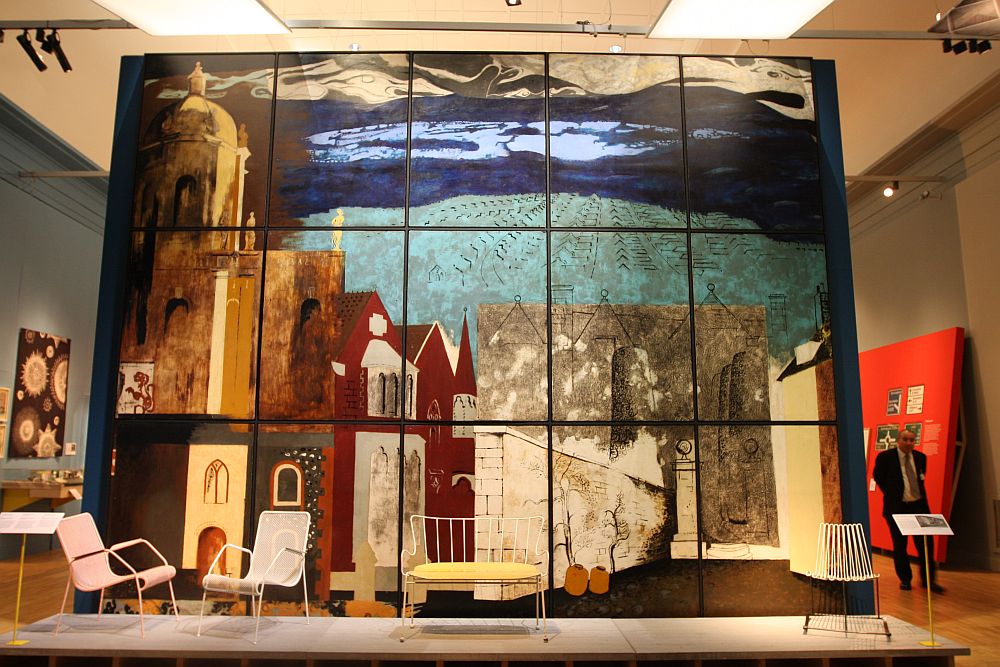At the end of March the V&A Museum London opened the exhibition "British Design 1948-2012. Innovation in the Modern Age", their major summer exhibition and a central pillar of their celebration of all things British throughout 2012.
Documenting the story of design in the UK since the last London Olympics, "British Design 1948-2012" begins in an era when Britain as a nation was recovering from the trauma of the Second World War, yet understood that in the rubble of the war lay the chance to renew its society and economy and so build for a brave new future.
And walking round "British Design 1948-2012" one is confronted by the inescapable truth that it was this process of renewal that was to lay the foundations for the story of modern British design.
For through the social re-organsiation, massed immigration, youth unemployment, et al the first youth sub-cultures emerged and as the exhibition makes very clear it is culture, specifically youth culture, that has been the biggest definer in the story of British design since the war.
A few years ago John Major famously spoke of Britain being about long shadows on cricket grounds and warm beer. There is no reference to such aspects of the British psyche in "British Design", save a fleeting if heartfelt appeal from Laura Ashley and a few contemporaries who were obviously struggling to come to terms with the decline of the empire, erosion of social boundaries and uncouth brutalist architecture sweeping the nation.
Their flirtation with a historical revival however is nothing more than an interesting blip on an otherwise uninterrupted trajectory. As Leith's leading cultural commentator would no doubt put it.
We're not saying that all British design episodes have had their origins in youth culture.
Nor are we saying that Britain's best designers were even influenced by the island's youth. Jasper Morrison, for example, became the designer he is because he visited a Memphis Group exhibition in Milan and then spent time in Berlin with Andreas Brandolini, Axel Kufus and other members of the "Neues deutsches Design" movement.
However what is unmistakable is the thread of youth culture that runs through the story of British design right up to the present day.
Well, no that's not entirely true.
Somewhere in the late 1990s the thread vanishes, but we'll come to that....

Taking a very wide definition of "design" and then squeezing as much as they can out of the sub-categories "British Design 1948 -2012" is reminiscent of an Essex Plaice - much wider than it is deep.
A fact that doesn't necessarily harm the exhibition or the visitor experience. It is after all a special thematic exhibition.
In a soon to be published interview, the director of a major European design museum tells us that, in effect, the role of museums is to use their collections to tell stories; they just need to decide which stories they want to tell. The V&A has decided to delve into the depths of its British collection to place post-war British design in its social, cultural and historical context
And has done that very well.
From the brutalism of the 1950s over the swinging sixties onto seventies punk, eighties rave, nineties Cool Britannia, and beyond the exhibition presents over 350 exhibits that wonderfully explain the development of design in the UK.
And ultimately poses one very obvious question. The 1948 Olympics and subsequent Festival of Britain kick-started the post-war British economy. What will the 2012 Games bring?
There is a great deal of expectation on the British Isles that the 2012 Olympic Games will also herald a brave new age.
They wont.
All the objects in the early decades of the exhibition were produced in the UK. We suspect largely out of necessity; there was no alternative. Today goods can be produced abroad. And the creations of the leading contemporary designers largely are.
Barber Osgerby currently work with Vitra, Magis, ClassiCon, flos. Benjamin Hubert with De Vorm, De La Espada, &Tradition. Doshi Levien with Moroso, Cappellini, Richard Lampert.
We approve. That's good. And is a situation that, if we're all honest, is unlikely to change. But does mean that regardless how successful British designers become, their contribution to the UK's GDP will remain negligible.
Then there is the nature of British design, for as the exhibition beautifully illustrates, Britain's "contemporary design tradition" is largely based on creating iconic, stylish and attractive objects. "British Design 1948-2012" doesn't feature any objects that one could say are truly innovative or started any particular global design movement.
"What about Concorde?" We hear the Daily Mail readers at the front of the class cry.
"Co-developed with the French and while unquestionably an iconic symbol of luxury air travel, what did Concorde actually contribute to modern aviation?" We reply.
And Jonathan Ives may have been knighted for his services to design: but he of course doesn't create what happens inside apple products. Just ensures that they look good. Or, put another way, creates iconic, stylish objects in the finest British design tradition.
As we've often stated, in the decades after the war increasing disposable incomes and social security created a market for consumer goods of the sort the likes of Mary Quant or Terence Conran were producing.
And the British youth with their unfaltering ability to transform harsh social reality into creative energy provided the musical backdrop. British design became part of a British style that was the envy of the world.
First punk and later rave may have superficially torn up the rule book; were in reality still based on standardised iconic symbolism underscored by new genres of music and literature.
Which means that to remain truly distinctive and desirable British design needs its yoof.
Oh, hang on.....
As we said, sometime in the mid 1990s one loses track of the youth culture thread. And while we'd love nothing more than to blame Damien Hirst and his YBA cronies. We can't
The problem is the internet, a medium that by its very nature snubs out youth cultures before they have a chance to establish themselves. The increased pace of our digital world meaning a mass movement like rave, arguably the last great youth culture and one which catapulted designers such as Tom Dixon into the limelight, will probably never again be possible.
And without the youth sub-cultures....
The "British Design 1948-2012" exhibition design was created by Ben Kelly. Who designed Malcolm McLaren & Vivienne Westwood's Kings Road boutique SEX. And the interior of the Hacienda.
We can't think of a more appropriate example for the importance of youth sub-cultures in guiding the fortunes of British designers.

We're not saying the situation is hopeless. British designers will undoubtedly remain very much in demand. But their careers will become increasingly dependent on foreign producers, producers whose commissioning decisions are based on global marketing and sales strategies rather than the organic, grassroots movements that established British design's reputation. As such the "British" in "British Design" will become increasingly difficult to define. But that is a question of national pride. Not design theory.
Consequently, "British Design 1948-2012. Innovation in the Modern Age" can either be viewed as the documentation of the past sixty years of British design combined with an attempt to place British design in a global context as the curators intended. Or as the first major retrospective of the Golden Age of British Design.
Either way it is an important exhibition and definitely worth viewing.
British Design 1948-2012. Innovation in the Modern Age runs at the V&A Museum London until August 12th 2012.
